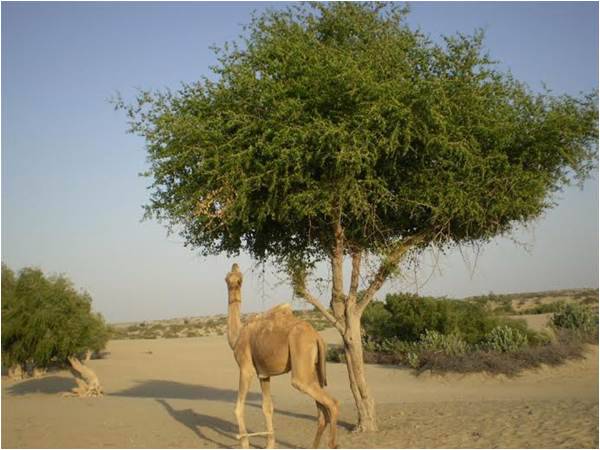
Gul Hassan was weeping at the death of his son Babu, who could not survive malnutrition in the famine-hit village of Hashim Jo Tar. Days ago, five of his goats had died. But he knew he was not alone. Most villagers of the white desert of Khipro Taluka suffered similar fate.
Achhro Thar, or White Desert, is a unique region of Pakistan known for its vast scattered dry sandy lands and naked barren sand dunes. It is located in eastern Sindh, spreading from Umerkot district in the south to Khairpur in the north, and from Sanghar district in the east to the Indian border on the west. It is not clear if the area is suffering from a natural disaster or the negligence of the state.
The white desert is known for its drastic droughts and disastrous famines because of acute water scarcity, low rainfall, high temperatures and hot winds. Around 90,000 people live in 249 small villages in the region. Depending only on their livestock for livelihood, they have been facing a dry spell spanning several years.
Achhro Thar is geographically important because of the dangerous quagmires spread along the Indian border that prevent possible invasions.
The region is amongst the poorest in Pakistan. The land is infertile and cannot produce any food crops. People travel to Khipro village to get food and water for themselves and fodder for their cattle. The lack of fodder and grazing opportunities in the rangelands has resulted in an 80 percent migration of cattle, 42 percent of sheep, 39 percent of goats and 6 percent of cows. High mortality rate and reduction in the weight of livestock have significantly reduced the income of the people in the drought-affected areas. Some villagers have been using wheat as fodder to preserve their cattle, which are often their only means of livelihood.
Since there is no potable water, the people of the desert depend on rains. The annual rainfall is very low, and most of it happens during the monsoon season, starting in July and ending in September. The intensity of the rain is high, but the frequency low.
The irregular rainfall period is followed by long dry periods with high evaporation and vapor transpiration because of high temperature, which dries the surface water reservoirs and groundwater aquifers.
Any meadows and fields in the area remain green for four or five months after the rains, but then dry up, leaving the residents no choice other than seasonal migration, which begins in January. Some people start moving to the barrage areas of Khipro (Sanghar district) while others move to small towns of Mirpur Khas districts with their livestock in search of fodder. If they can’t make it, they have to sell their cattle for cheap. Half of the price they get is spent in transporting the cattle from their villages to Khipro.
Achhro Thar, or White Desert, is a unique region of Pakistan known for its vast scattered dry sandy lands and naked barren sand dunes. It is located in eastern Sindh, spreading from Umerkot district in the south to Khairpur in the north, and from Sanghar district in the east to the Indian border on the west. It is not clear if the area is suffering from a natural disaster or the negligence of the state.
The white desert is known for its drastic droughts and disastrous famines because of acute water scarcity, low rainfall, high temperatures and hot winds. Around 90,000 people live in 249 small villages in the region. Depending only on their livestock for livelihood, they have been facing a dry spell spanning several years.
Achhro Thar is geographically important because of the dangerous quagmires spread along the Indian border that prevent possible invasions.
The region is amongst the poorest in Pakistan. The land is infertile and cannot produce any food crops. People travel to Khipro village to get food and water for themselves and fodder for their cattle. The lack of fodder and grazing opportunities in the rangelands has resulted in an 80 percent migration of cattle, 42 percent of sheep, 39 percent of goats and 6 percent of cows. High mortality rate and reduction in the weight of livestock have significantly reduced the income of the people in the drought-affected areas. Some villagers have been using wheat as fodder to preserve their cattle, which are often their only means of livelihood.
Since there is no potable water, the people of the desert depend on rains. The annual rainfall is very low, and most of it happens during the monsoon season, starting in July and ending in September. The intensity of the rain is high, but the frequency low.
The irregular rainfall period is followed by long dry periods with high evaporation and vapor transpiration because of high temperature, which dries the surface water reservoirs and groundwater aquifers.
Any meadows and fields in the area remain green for four or five months after the rains, but then dry up, leaving the residents no choice other than seasonal migration, which begins in January. Some people start moving to the barrage areas of Khipro (Sanghar district) while others move to small towns of Mirpur Khas districts with their livestock in search of fodder. If they can’t make it, they have to sell their cattle for cheap. Half of the price they get is spent in transporting the cattle from their villages to Khipro.

